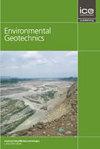Attenuation of erythromycin-laden waste water using the constructed wetland technique
IF 2.2
4区 工程技术
Q3 ENGINEERING, GEOLOGICAL
引用次数: 0
Abstract
Erythromycin (ERY) is environmentally resilient because of its aromatic nature, which hinders degradation. In the present study, silty–sandy soil, with a saturated hydraulic conductivity (K) value of 1.66 × 10−7 m/s, was studied for its potential to remove aqueous ERY using a laboratory-scale constructed wetland. With a dose of 10 g/l, a concentration of 25 mg/l and a contact time of 30 min, the maximum adsorption reached 89.79 ± 1.5%, as found from batch experiments. The Freundlich isotherm (R 2 = 0.983, n = 0.575, K f = 0.04 mg/g) was the best fitting among different user models. In the kinetic study, the pseudo-second-order model (q e = 1.297 mg/g, K 2 = 0.182 g/(mg min)) had the best fit with experimental data. A one-dimensional vertical column study exhibited an exhaustion time of 2.7 days for a 40 mm deep soil bed to remove ERY. A laboratory-scale constructed wetland model composed of silty–sandy soil showed a reduction of ERY of 92.44%. Finally, the results were validated with the CW2D wetland model of the Hydrus software, which corroborated the experimental results. The outcome exhorts that constructed wetlands with silty–sandy soil may be an effective technique for the reduction of ERY present in waste water, which has profound importance from a social health perspective.人工湿地技术对含红霉素废水的衰减
红霉素(ERY)具有环境适应性,因为它的芳香性阻碍了降解。在本研究中,我们利用实验室规模的人工湿地,研究了饱和水力传导性(K)值为1.66 × 10−7 m/s的粉砂质土壤去除水中ERY的潜力。当剂量为10 g/l,浓度为25 mg/l,接触时间为30 min时,最大吸附量为89.79±1.5%。Freundlich等温线(r2 = 0.983, n = 0.575, K f = 0.04 mg/g)在不同用户模型中拟合最佳。在动力学研究中,拟二阶模型(q e = 1.297 mg/g, K 2 = 0.182 g/(mg min))与实验数据拟合最好。一项一维垂直柱研究表明,40毫米深的土床需要2.7天的耗尽时间才能去除ERY。粉砂质土壤组成的实验室尺度人工湿地模型的ERY降低率为92.44%。最后,利用Hydrus软件的CW2D湿地模型对结果进行验证,验证了实验结果。结果表明,粉砂质土壤人工湿地可能是一种减少废水中ERY的有效技术,从社会健康的角度来看,这具有深远的意义。
本文章由计算机程序翻译,如有差异,请以英文原文为准。
求助全文
约1分钟内获得全文
求助全文
来源期刊

Environmental geotechnics
Environmental Science-Water Science and Technology
CiteScore
6.20
自引率
18.20%
发文量
53
期刊介绍:
In 21st century living, engineers and researchers need to deal with growing problems related to climate change, oil and water storage, handling, storage and disposal of toxic and hazardous wastes, remediation of contaminated sites, sustainable development and energy derived from the ground.
Environmental Geotechnics aims to disseminate knowledge and provides a fresh perspective regarding the basic concepts, theory, techniques and field applicability of innovative testing and analysis methodologies and engineering practices in geoenvironmental engineering.
The journal''s Editor in Chief is a Member of the Committee on Publication Ethics.
All relevant papers are carefully considered, vetted by a distinguished team of international experts and rapidly published. Full research papers, short communications and comprehensive review articles are published under the following broad subject categories:
geochemistry and geohydrology,
soil and rock physics, biological processes in soil, soil-atmosphere interaction,
electrical, electromagnetic and thermal characteristics of porous media,
waste management, utilization of wastes, multiphase science, landslide wasting,
soil and water conservation,
sensor development and applications,
the impact of climatic changes on geoenvironmental, geothermal/ground-source energy, carbon sequestration, oil and gas extraction techniques,
uncertainty, reliability and risk, monitoring and forensic geotechnics.
 求助内容:
求助内容: 应助结果提醒方式:
应助结果提醒方式:


